LAB REPORT
Science and Technology Making Headlines
May 6, 2016

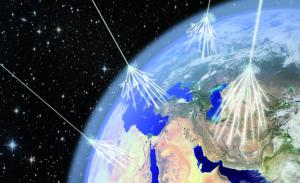
An illustration of “air showers” that result when ultra-high-energy cosmic rays strike the top of the Earth’s atmosphere and collide with air nuclei, producing other particles that lose most of their energy before reaching the ground. Image courtesy of Asimmetrie/INFN, via CERN
Shining a light on cosmic rays
The Earth is under constant bombardment by subatomic particles called cosmic rays, including some, known as ultra-high-energy cosmic rays, which pack much more punch than the world's most powerful particle accelerators. Fortunately, Earth's atmosphere protects us by dissipating most of that energy before it reaches the ground.
But where do these ultrafast cosmic rays come from, and how are they accelerated to such high energies — one quadrillion electron volts and more? Scientists have been searching the heavens for answers to those questions for many decades, yet much about the origin and nature of ultra-high-energy cosmic rays remains a mystery.
Now an international team of researchers, including those from Lawrence Livermore, is trying a different approach. Instead of looking deep into the universe with telescopes, or trying to capture the debris from atmospheric cosmic-ray collisions with particle detectors, they're trying to duplicate the actual conditions that could contribute to cosmic-ray acceleration right here on Earth, in the National Ignition Facility (NIF) target chamber.

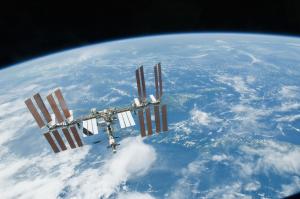
The Lawrence Livermore Microbial Detection Array (LLMDA) will be on board the International Space Station. Image courtesy of NASA
Looking for extraterrestrial microbes
A team of scientists from Lawrence Livermore and three NASA research centers will use the Lawrence Livermore Microbial Detection Array (LLMDA) to study microbes that are associated with astronauts and found inside the closed environment aboard the International Space Station.
The LLMDA is a versatile tool that has been employed for all kinds of studies, from analyzing the purity of infant vaccines to detecting plague in a 14th century tooth to learning more about combat wounds from soldiers injured in Iraq and Afghanistan.
Researchers from NASA’s Jet Propulsion Laboratory in Pasadena; NASA’s Ames Research Center in Moffett Field, California; NASA’s Johnson Space Center in Houston, and LLNL have received a three-year, $1.5 million NASA grant for characterizing microbes using state-of-the-art molecular techniques.
“The aim of the project is to provide a survey of the microbial profiles inside the International Space Station and to evaluate the possibility of the presence of pathogens that could be harmful to the astronauts’ health,” said LLNL biologist Crystal Jaing, the project’s principal investigator.

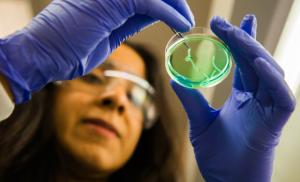
Monica Moya and colleagues are 3D bioprinting blood vessels. Photo by Lanie L. Rivera.
Fixing a ‘plumbing problem’ in tissue engineering
Tissue engineering can't expand into three dimensions as long as cells can't access oxygen and nutrients via blood vessels. This remains a big challenge for the printable organ and tissue engineering communities.
Monica Moya and Elizabeth Wheeler, biomedical engineers at Lawrence Livermore National Laboratory, are working on a way to solve this “plumbing problem,” as Moya puts it, using 3D bioprinting.
Moya has previously developed microfluidic devices to test the effect of mechanical cues on vessel growth. Now she and Wheeler are collaborating on moving to a 3D printing platform.
First, they had to make sure that the printing techniques were compatible with cell viability. They had to change out the extrusion and fluidic parts of a standard 3D printer, to eliminate the high temperatures and shear forces that would kill the cells.

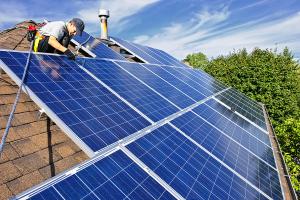
More residential and business owners are opting to buy solar panels rather than lease them.
Homes are booming with solar
The price of rooftop solar systems for residential and small business continues to drop, and consumers are increasingly choosing to buy their systems rather than lease them to reap the full financial benefits.
Rooftop solar systems that used to cost as much as a luxury car five to 10 years ago now cost about the same as an economy car, or about $15,000 or $18,000 on average. And, the return on investment for a solar system is now estimated to be from three to five years, depending on government rebates and tax incentives and the region where they're installed.
Taken together, tremendous drops in hard and soft costs have lowered the installation price for rooftop solar panels to about $3 to $4 per watt of installed capacity; the average installation today is 5kW (kilowatts), according to a report by the Lawrence Livermore National Laboratory. That puts the cost of a typical system at between $15,000 and $20,000.
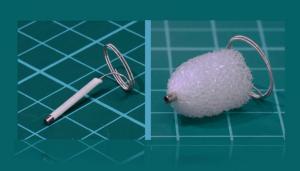
Microstructures of two different foam materials. At left, a traditional open-cell stochastic foam, and at right, a 3D printed foam with the face-centered tetragonal lattice structure.
Not your usual foam
According to material scientists at Lawrence Livermore National Laboratory, 3D-printed foam is more durable and functional than cellular materials.
Traditional foams, or cellular solids, have a wide variety of industrial applications. They're used for insulation and shock absorption, found in airplane wings and boat hulls.
To see if foams created by 3D printers could stand up to traditional foams, a team of researchers at LLNL put a series of foams through an advanced aging process -- subjecting them to a series of stress tests to replicate weeks and months of wear and tear.
Foams made via 3D printing aged slower, maintaining their mechanical and structural characteristics for longer.





